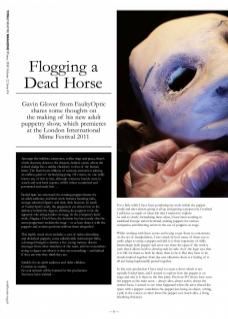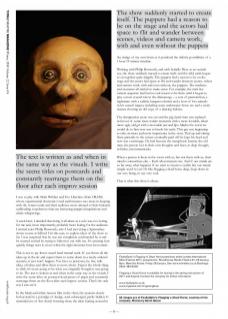FaultyOptic are renowned for creating puppet theatre for an adult audience, and their work features haunting tales, strange animated figures and dark, dark humour. In much of FaultyOptic’s work, the puppeteers are almost lost in the darkness behind the figures, allowing the puppets to be the apparent sole acting bodies on stage. In the company’s latest work, Flogging a Dead Horse, the decision has been made that the actor/puppeteers reclaim the stage – or at least share it with the puppets and at times perform without them altogether!
This highly visual show includes a cast of rather disturbing and disturbed puppets, some unbelievable microscopic films, a deranged kangaroo dentist, a live roving camera, distant messages from other members of the team, and two researchers trying to figure out what it is they are researching – and indeed if they are who they think they are.
Suitable for an adult audience and older children.
Contains no nudity.
No real animals will be harmed in this production.
You have been warned…
For a little while I have been pondering my work within the puppet world and after almost giving it all up and getting a proper job, I realised I still have a couple of ideas left that I wanted to explore. As well as slowly formulating these ideas, I have been working in mainland Europe and in Scotland, making puppets for various companies and directing actors in the use of puppets on stage.
Whilst working with these actors and trying to get them to concentrate on the art of manipulation, I was struck by how many of them can so easily adapt to using a puppet and add it to their repertoire of skills. Interestingly both puppet and actor can share the space if the work is such that it allows both to develop side-by-side. So if the logic says that it is OK for them to both be there, then so be it. But they have to be closely knitted together from day one otherwise there is a feeling of it all just being haphazardly pasted together.
In this new production I have tried to create a show which is not typically FaultyOptic, and I started to explore how the puppet is on stage and why it is there in the first place. Previous FO shows have seen the puppet as the main actor – always alive, always active, always the central focus. I started to see what happened when the actor shared the space with a puppet: sometimes the puppet just being an object, a thing, a pile in the corner; at other times the puppet very much alive, a living breathing character.
In Flogging a Dead Horse I started, as I often did when creating a FO show, with a rough notion of the theme of the show, made some rough drawings and then started making some things, puppets, machines, situations – partly for my own amusement, partly knowing that what I was making might not actually get used at all, but if it was made, it stood a chance of joining in the madness later on in the process.
The themes were basically a collection of wild cards:
• Sperm whales and their incredible evolution to survive in the most extreme of conditions
• Oscar Wilde’s Salome with the victim/master/manipulator relationship between each of the three main characters: John the Baptist, Herod and Salome
• Brains, neurons, the depths of our subconscious and our thinking processes
• Stand-up comedians
• A few other even wilder cards which I can’t even remember now but were quickly discarded
And technically, a desire that everything is visible to the audience, and an awareness that the sound manipulation is just as important as the puppet manipulation. No more miraculous cinematic effects that we all take for granted when we see a show! If a DVD is to be seen, let’s see it go into the DVD player.
So I made a leather whale which could talk back; an innocent faced yellow puppet in a long coat; and a life-sized pig-faced man who could be dismantled, and who sat tied up in a chair with a gag in his mouth. Maybe my love/hate relationship with puppets was surfacing as I really wanted to start to be destructive and destroy their misty-eyed integrity. My barbershop John the Baptist victim was going to lose his head after some relentless hairdresser interrogations.
So the jigsaw puzzle pieces had been made and the game of devising the show had started. Perhaps overconfidently believing the show would simply create itself, which of course it didn’t, I was left realising I was facing something uncomfortably familiar, a rather large overwhelming feeling of deja vu. The show was also to be a solo. I have found, however frustrating, however much time one wastes, this is the only way I know to create a devised show. It’s like flogging a dead horse and I always swear never to make another one again!
Back in June 2010, I did do a two-week residency in a music venue in Brussels called Atelier Claus – they generously support artist performers and open their space for creations with the promise of a public showing at the end of it. So it was that the creativity started amid technical problems and the closure of the venue after day five due to health and safety concerns (the venue had no fire exits). So the show was hurriedly rescheduled to another arts centre.
I was to play with Mark Webber and Eve Libertine (from CRASS) whose experimental electronic/vocal performance was more in keeping with the venues remit and their audience more attuned to their fantastic ear-bleeding soundwaves than my bemusing puppet decapitations and whale whisperings.
A week later, I decided that doing it all alone as a solo was too boring for me and, more importantly, probably more boring for the audience. I invited actor Philip Bosworth, who I had met doing a Spymonkey clown course at Salford Uni this year, to explore ideas of the show so far. I was surprised that he was not completely confounded by it and he seemed excited by trying to fathom it out with me. It’s amazing how quickly things start to move when the right decisions have been made.
This is not to say that it wasn’t hard mental work. If you throw all the ideas up in the air and expect them to come down in a nicely ordered scenario, it just won’t happen. You have to persevere, be free with ideas, oil ideas and allow them to move about. Expect the whole thing to shift; it’s never going to be what you originally thought it was going to be. The text is written as and when in the same way as the visuals. I write the scene titles on postcard-sized pieces of paper and constantly rearrange them on the floor after each improv session. That’s the only way I can see it.
In the black-and-white neuron film in the show, the neurons slowly bob around in a porridge of sludge, semi submerged, partly hidden. It reminded me of this slowly forming show, the ideas batting around in the sludge of my own brain as it pondered the infinite possibilities of a 1 hour 15 minute timeline.
Working with Philip Bosworth, and with Isabelle Wery as an outside eye, the show suddenly started to create itself and the wild cards began to sit together quite happily. The puppets had a reason to be on the stage and the actors had space to flit and wander between scenes, videos and camera work, with and even without, the puppets. The madness and nonsense all started to make sense. For example, the mini live camera sequence had had no real reason to be there until it began to play a more crucial role in the dramaturgy – a sort of premonition, a nightmare with a sadistic kangaroo dentist and a host of lost animals in his surreal surgery including some underwater horse sex and a seedy cinema showing an old copy of a dancing Salome.
The decapitation scene was cut and the pig-faced man was replaced in favour of some more tender moments with a more loveable, albeit more ugly, old git with a moveable jaw and lips. Maybe the worst we would do to him now was to brush his teeth. This guy was beginning to take on more and more importance in the story. Tied up and sitting there patiently in the corner eventually paid off: he kept his head and now was centrestage. He had become the metaphoric hermit, the old man, the person lost in their own thoughts and fears, in deep thought, in limbo, incommunicado.
When a person is there in the room with us, but not there with us, their mind is somewhere else – that’s what interests me. And if our minds are so far away, what happens if we want to return to reality but our minds simply won’t let us? It’s like flogging a dead horse deep, deep down in our very being, in our very soul.
That is what this show is about.
FaultyOptic’s Flogging A Dead Horse premieres at the London International Mime Festival 2011, presented at Roundhouse Studio Theatre 27–29 January, 8pm. Meet the Artists: Friday 28 January. See www.mimefest.co.uk Bookings: 0844 482 8008
Flogging a Dead Horse is available for touring in the spring and autumn of 2011 and beyond. Contact the company for further information.



